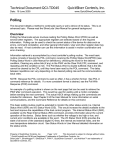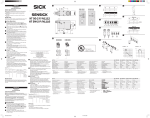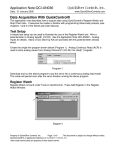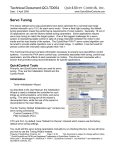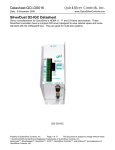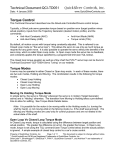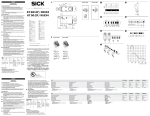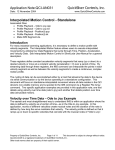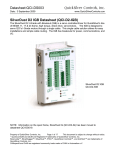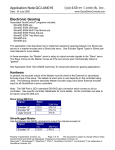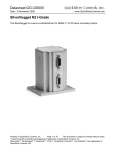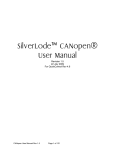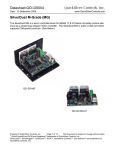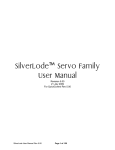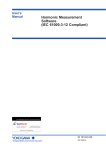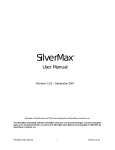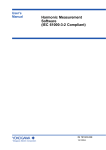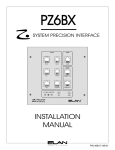Download Application Note:QCI-AN034 QuickSilver Controls, Inc. Rotary Knife
Transcript
Application Note:QCI-AN034 Date: 18 July 2008 QuickSilver Controls, Inc. www.QuickSilverControls.com Rotary Knife Included files: • QCI-AN034 Rotary Knife.pdf: This document • Rotary Knife – Simple - Fixed.qcp • Rotary Knife – Simple - Dynamic.qcp • Rotary Knife - Registration.qcp • Rotary Knife - Simple SN.qcp Introduction Rotary knife systems are widely used to cut, seal or perforate material moving along a conveyor. Rotary knife system consists of a cylinder with a knife blade fastened along the longitudinal axis. As the cylinder rotates, it cuts the material passing underneath it. During the cut, the tangential knife velocity must match the linear speed of the material. During the rest of the revolution, the knife must either speed up or slow down to be ready for the next cut. Most rotary knife applications are continuous operation with material continuously moving along the conveyer belt. The knife axis (slave) is geared electronically to the feed axis (master) so that the material cut lengths are independent of the material feed speed. Property of QuickSilver Controls, Inc. Page 1 of 14 This document is subject to change without notice. QuickControl® and QCI® are Registered Trademarks of QuickSilver Controls, Inc. SilverLode™, SilverNugget™, SilverDust™, PVIA™, QuickSilver Controls™, and AntiHunt™ are trademarks of QuickSilver Controls, Inc.. Application Note:QCI-AN034 QuickSilver Controls, Inc. This document will discuss two types of rotary knife applications, Simple and Registration. Direction of Rotation In the Simple application, the material length is fixed in the program or selected by an operator and the cuts are made continuously. Direction of Rotation Material Feed Master Encoder Knife Rotary Knife - Simple Material Feed Master Encoder Knife Registration Marks Registration Mark Sensor (RMS) Rotary Knife - Registration QuickSilver Controls, Inc. Page 2 of 14 The Registration application adds a Registration Mark Sensor (RMS) that detects a registration mark on the material where the cut is to be made. The material length is variable and the RMS may be several material lengths from the knife. QuickSilver Controls, Inc. Application Note:QCI-AN034 Rotary Knife - Simple The material feed is continuous. The knife speed matches the material speed for the Cut Segment(CS) and then, depending on Material Length (Mn), speeds up or slows down during the Return Segment(RS) to get into position for the next cut. Knife Return Segment (Krs) Knife Cut Segment (Kcs) Knife Radius (R) Mrs Mcs Mn Mn is set by the operator or hard coded in the program. Application Specific Parameters • Knife Counts/Rev (Kcpr): Kcpr is the number of knife encoder counts for 1 revolution of the Knife. Kcpr = <user defined> • Knife Cut Segment (Kcs): Number of knife encoder counts for Cut Segment (CS). This is somewhat arbitrary. It needs to be long enough to clear the material at both ends. It also needs to be long enough to allow the knife to settle into matching speed prior to engaging the material. The following is a good default number: Kcs = Kcpr/4 • Knife Return Segment (Krs): Knife encoder counts for Return Segment (RS). This is just the rest of the knife's rotation. Krs = Kcpr - Kcs • Cut Segment Scale Factor (SFcs): Scale Factor (SF) for CS. The Rotary Knife is an electronic gearing application, therefore a key calculation that needs to be made is the EGM command's Scale Factor (SF). SF is basically a gear ratio between the knife (slave) and master. See Application Note “QCI-AN019 Electronic Gearing” for more information. The general equation of SF is: SF = SF1 * GR where SF1 is SF for a 1:1 ratio. In other words if SF=SF1, the knife axis would move the same number of encoder counts as the master. SF1 is not user settable and is automatically calculated in the program. QuickSilver Controls, Inc. Page 3 of 14 Application Note:QCI-AN034 QuickSilver Controls, Inc. Gear Ratio (GR) is the slave axis movement (knife encoder counts) movement over the given master axis movement (master encoder counts) that synchronizes the knife to material passing beneath it. GR should be less than 1.0 for smooth operation. GRs of 1.0 and greater will require servo tuning. Therefore, the Cut Segment Scale Factor (SFcs) is as follows: SFcs = SF1 * GR SFcs = SF1 * Kcs/Mcs GR = Kcs/Mcs <= 1.0 • Material Length (Mn): Material Length in Master Encoder Counts. In the “Rotary KnifeSimple-Fixed.qcp” example, Mn is fixed at the beginning of the program file. In the “Rotary Knife-Simple-Dynamic.qcp” example, Mn can changed from a host (i.e. HMI) in real time. Mn = <user defined> • Master Cut Segment (Mcs): Master encoder counts for CS. Mcs is calculated from Kcs using GR. Mcs = Kcs/GR Mcs = Kcs * SF1/SFcs • Master Return Segment (Mrs): Master encoder counts for RS. Mrs = Mn - Mcs QuickSilver Controls, Inc. Page 4 of 14 Application Note:QCI-AN034 QuickSilver Controls, Inc. Setup 1) Initialize the servo as described in the User Manual chapter 1. The application assumes the knife rotates in the servo's "positive" direction. You may need to edit the DIR command in the Initialization Wizard to change the servo's positive direction. Servo Positive Rotation Knife 2) Attach the servo to the knife axis, aligning the encoder index with the knife blade at the end of the Cut Segment. This can be done by either physically aligning the index mark on the motor's shaft or by running a program to make the motor move to its index. See the example file included with QuickControl: QCI Examples\Homing Routines\Home To Encoder Index.qcp 3) Wire the servo for electronic gearing by connecting the master encoder A/B signals to the controller's I/O #6 and #7. See Application Note "QCI-AN019 Electronic Gearing" for more information. It is assumed the master encoder rotates in the positive direction. Reverse the A/B signals to reverse your master encoder. QuickSilver Controls, Inc. Page 5 of 14 Application Note:QCI-AN034 QuickSilver Controls, Inc. Servo Positive Rotation Rotary Knife-Simple-Fixed.qcp Requires: • QuickControl 4.64 • SilverDust Firmware 37 Knife The following is an overview of "Rotary Knife-Simple-Fixed.qcp". This QCP is well documented and should be easy to follow. The following overview in combination with the rest of this app note and the QCP's source code remarks should allow the user to modify the QCP for their specific needs. This program file is composed of the following programs: Init Initialize application specific and derived parameters (registers) and setup the servo for an electronic gearing application. On completion, "Init" runs the "Home to Index" program. The only registers you should have to edit for your application are Kcpr, SFcs, and Mn. Home to Index Homes the servo to its internal index pulse. Note how electronic gearing is used to rotate the knife at the Cut Segment's matching speed. This ensures the knife will not bind during the homing process. Once the index is found, the encoder is zeroed to the index location and the "Rotary Knife" program is run. QuickSilver Controls, Inc. Page 6 of 14 Application Note:QCI-AN034 QuickSilver Controls, Inc. Rotary Knife This program uses the EGM command to run in the rotary knife function in the background. Knife Return Segment Geared (Krsg) is the distance the knife would move during the RS if it stay geared at the synchronous scale factor of SFcs. This is used as a “base” distance to calculate how much more or less the EGM command’s Trapezoid Move feature needs to move during the RS to be ready for the next cut. Krsg = Mrs * GR = Mrs * SFcs/SF1 Note that we have to use the 64 bit multiple and divide to not overflow the 32 bit registers. The EGM Trapezoid Move Registers define the distance the knife will move during the RS. • Start Position (SP)= 0: Start immediately. • Master Distance (MD)=Mrs • Move Ramp Distance (MRD)=MD/100: Nice easy acc/dec. • Trapezoid Move Distance (TMD)=Krs-Krsg: The distance TMD is the “extra” distance the knife will travel during the RS. Note this is in addition to the distance traveled as normal electronic gearing (Krsg). Negative values of TMD mean the knife will rotate slower than during the CS. • Master Modulo Distance (MMD)=Mn: Modulo every Mn. EGM is launched and runs in the background while the “Main Loop” is executed for user specific code. QuickSilver Controls, Inc. Page 7 of 14 Application Note:QCI-AN034 QuickSilver Controls, Inc. Rotary Knife-Simple-Dynamic.qcp Requires: • QuickControl 4.64 • SilverDust Firmware 37 Servo Positive Rotation Knife The following is an overview of "Rotary Knife-Simple-Dynamic.qcp". This is very similar to “Rotary Knife-Simple-Fixed.qcp" except the EGM command is not run in modulo mode, but, instead, is executed every Mn to allow for Mn to change on the fly (i.e. using an HMI). This program file is composed of the following programs: Init Same as “Rotary Knife-Simple-Fixed.qcp", except Mn can be thought of as an initial value. Home to Index Same as “Rotary Knife-Simple-Fixed.qcp". Rotary Knife EGM is executed for each Mn or, in other words, for each knife revolution. Each pass through “Main Loop” is one revolution. Mrs is re-calculated in case Mn has changed. The EGM Trapezoid Move Registers define the distance the knife will move during the RS. All the parameters are the same “Rotary Knife-Simple-Fixed.qcp" except there is no MMD and EGM is configured execute only one Trap Move. While EGM is executing, the program waits for one complete revolution of the knife. After which, the knife’s position is modulo down by one revolution and we jump back to the start for the next pass. QuickSilver Controls, Inc. Page 8 of 14 QuickSilver Controls, Inc. Application Note:QCI-AN034 Rotary Knife - Registration Requires: • QuickControl 4.64 • SilverDust Firmware 37 Direction of Rotation This version of the Rotary Knife uses a sensor (RMS) to read registration marks on the material to calculate the Material Length (Mn). Since there could be several registration marks between the knife and the RMS, the program needs to queue up several lengths. Knife Material Feed Master Encoder Registration Marks Registration Mark Sensor (RMS) In the case where the RMS stops detecting registration marks (i.e. material is not present), the knife comes to a stop after the Cut Segment. Once a mark is read, the knife starts back up again to get into position for the next cut. Additional Application Specific Parameters • Maximum Material Length in Master Encoder Counts (Mmax): Mmax is also the distance from the RMS to end of Mcs. Knife Return Segment (Krs) Knife Cut Segment (Kcs) Mcs RMS Mrs Mn-2 Mmax = <user defined> Mn-1 Mn Mmax • Minimum Material Length (Mmin): You may change Mmin to an Application Specific Parameter if you have a particular Mmin you want to enforce. The smaller Mmin the faster the knife axis will have to go. Be careful not to exceed the knife's maximum speed. By default Mmin is: Mmin = Mcs Mmin < Mmax Mmin = <user defined> Material Length (Mn): Mn is automatically calculated by reading the difference between two registration marks. NOTE: Because the difference between two readings is being used to calculate Mn, the RMS delay or de-bounce time is cancelled out. Therefore, a high-speed RMS is not required. NOTE: The 2's complement math makes the equation work even through master encoder rollover. QuickSilver Controls, Inc. Page 9 of 14 Application Note:QCI-AN034 QuickSilver Controls, Inc. Setup 1) Do Simple version steps 1-3. 2) Wire RMS to I/O#1 with an HIGH meaning registration mark detected. The only place this input is used is in the WBE command at the beginning of "T2: Queue Mn". Modify this WBE command if your RMS is not active HIGH on I/O#1. 3) Edit the "Application Specific Parameters" section of the "Rotary Knife - Registration.qcp" "Init" program. Edit the registers using information from your application. QuickSilver Controls, Inc. Page 10 of 14 Application Note:QCI-AN034 QuickSilver Controls, Inc. Rotary Knife – Registration.qcp The following is an overview of the Rotary Knife - Registration.qcp file. This program file is composed of the following programs. Init Same as “Rotary Knife-Simple-Fixed.qcp” except: • Moved Mn and Mrs to “Rotary Knife” program. • Added Mnmax/Mnmin which defines the longest and shortest material lengths. Home to Index Same as “Rotary Knife-Simple-Fixed.qcp” except: • Thread 2 (Queue Mn) is started after index found (see below for details). Rotary Knife This program is similar to the same program in “Rotary Knife-Simple-Dynamic.qcp” except that Mn is retrieved (popped) from the queue “Q” (see below for details on Q). If Q is empty, SF is set to zero to stop the knife and we jump back to the start. Once a valid Mn is received, the EGM command is used the same as “Rotary Knife-SimpleDynamic.qcp”. Note, the first Mn after an empty Q, causes the knife to start from a stop. The EGM first ramps up to speed using AF and SF and then executes the Trap Move to move the knife to the correct place for the cut. You will see the knife start up quickly as it ramps up to speed and then slow down as the Trap Move is executed. This is normal. QuickSilver Controls, Inc. Page 11 of 14 Application Note:QCI-AN034 QuickSilver Controls, Inc. T2: Queue Mn Reading the RMS and queuing up the Mn's is done in the controller's 2nd program thread. This is actually a separate program running in parallel to the thread 1 programs (Init, Home to Index, and Rotary Knife). See Multi-Thread in User Manual for details. This program calculates the Mn's and "pushes" them onto a queue to be later "popped" off and used by the Rotary Knife program. The queue is first set to hold a maximum of 50 Mn's. The Main Loop waits for RMS to go HIGH and then saves the master encoder position (reg 200) into a user register, “Reg Mark”. Mn is calculated by comparing the current “Reg Mark” with the “Last Reg Mark”. Mn = Reg Mark – Last Reg Mn is then forced to be within the user defined min/max. Mn is pushed onto Q. If more than 50 Mn’s are pushed onto the queue, thread 1 is forced to load and run the Fault program and thread 2 halts. Fault Fault stops the servo and enters an infinite loop. The infinite loop keeps the program running which is nice when using QuickControl's Real-Time Trace feature to identify what the program is doing. QuickSilver Controls, Inc. Page 12 of 14 Application Note:QCI-AN034 QuickSilver Controls, Inc. Rotary Knife - Simple SN.qcp The following is an overview of "Rotary Knife-Simple SN.qcp". This is very similar to “Rotary Knife-Simple-Dynamic.qcp" except it is written for the SilverNugget. Instead of the EGM command, the SilverNugget uses the RSD command. The SilverNugget does not support the extended calculation commands CLD/CLX so the calculations usually require a little more code. This program file is composed of the following programs: Init Same as “Rotary Knife-Simple-Dynamic.qcp" except as noted above. Home to Index Same as “Rotary Knife-Simple-Dynamic.qcp" except as noted above. Rotary Knife This program switches the Registered Step and Direction (RSD) command's Scale Factor (SF) between the Cut Segment Scale Factor (SFcs) and the Return Segment Scale Factor (SFrs). Return Segment Scale Factor (SFrs): Scale Factor (SF) for RS. The desired knife movement is Krs (the rest of the knife rotation). While the knife goes the distance Krs, the master must move the rest of material pass the knife. The material distance Mcs has already passed, therefore the master just has to move Mrs=Mn-Mcs. SFrs is therefore, SFrs = SF1 Krs/Mrs QuickSilver Controls, Inc. Page 13 of 14 Servo Positive Rotation Knife Application Note:QCI-AN034 QuickSilver Controls, Inc. Other Considerations Programmable Limit Switch (PLS) A PLS could be used to signal "End of Cut" to allow an outfeed stage to process the newly cut piece. The PLS would be added to the knife program and configured to trigger sometime after the Knife Cut Segment (Kcs). See Application Note QCI-AN050 Programmable Limit Switch for details. Control Constants In an Electronic Gearing application, the slave has to determine its target position from incoming master encoder counts. Because there is no pre-planed trajectory to follow, the servo loop does not have acceleration feedforward information. This is less of an issue as the line is typically brought up to speed slowly (low acceleration). The various Step and Direction routines estimate velocity feedforward from incoming master encoder counts. CTC CTC start with factory defaults and make the following change: Ki=0 for increased stability. Increase Ki if your application requires the servo to firmly hold its position while stopped. NOTE: Kv2 may need to be increased for larger inertial mismatches (10+). See Technical Document "QCI-TD054 Servo Tuning". Missing Register Marks “Rotary Knife – Registration.qcp” assumes the products can change length (Mn) often. It cannot, therefore, distinguish between a missing registration mark and an extra long product. If your application only has only small changes in Mn, a missing mark can be identified and Mn for the missing mark can be calculated using the past Mn’s. QuickSilver Controls, Inc. Page 14 of 14














